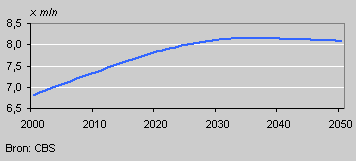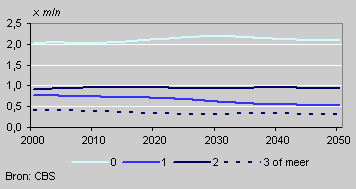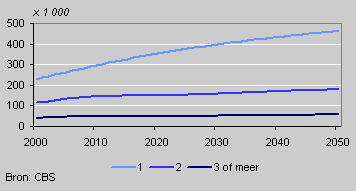More singles and fewer couples in 2050

Between 2005 and 2035 the number of households will increase from 7.1 to 8.2 million. Subsequently, the number of households will decrease marginally to 8.1 million in 2050.
Number of households

Average household will be smaller
The increase in the number of households will mainly occur among singles. As a result, the average number of household members will decline from 2.3 in 2005 to 2.1 in 2035. This trend emerges from the Household forecast recently published by Statistics Netherlands.
Households by type

Number of singles will rise substantially
Until 2035 the number of singles will grow by nearly 1 million, approximately as many men as women. Subsequently, the number of singles will remain stable at 3.5 million.
There are various explanations for the increase in the number of singles. Firstly, young people more often decide to live on their own for a while. At the same time, ageing people remain independent until late in life.
Secondly, the anticipated rise in the number of unmarried couples will eventually result in more singles, as cohabiting partners more often go their separate ways than married couples.
Thirdly, the ageing of the population is an important factor to contribute to the future increase in singles. The number of singles aged 75 and older, for example, will double from 450 thousand in 2005 to 920 thousand in 2050.
Couples by number of children

Fewer couples with children
The number of couples will decline from 4.1 million in 2005 to 3.9 million in 2050. These will mainly be couples with children. The number of couples without children, on the other hand, will grow from 2.0 million to 2.1 million in the period 2005–2050. As a result, 54 percent of couples will have no child at home in 2050. Currently, 49 percent of couples have no children at home.
One-parent families by number of children

More one-parent families
In the decades to come the number of one-parent families will rise considerably. In 2050 there will be 700 thousand one-parent families, as against 450 thousand in 2005. The most frequent type of one-parent families will have one child, partly because divorces are more common among couples with one child than among couples with two or more children.
Han Nicolaas